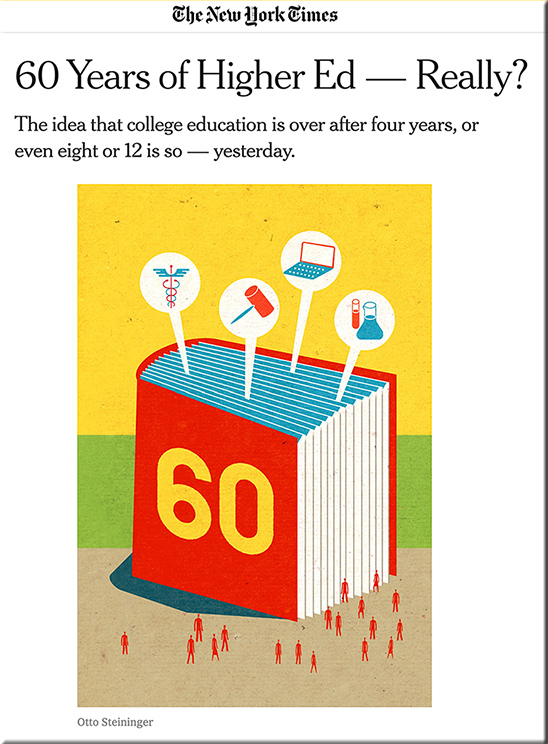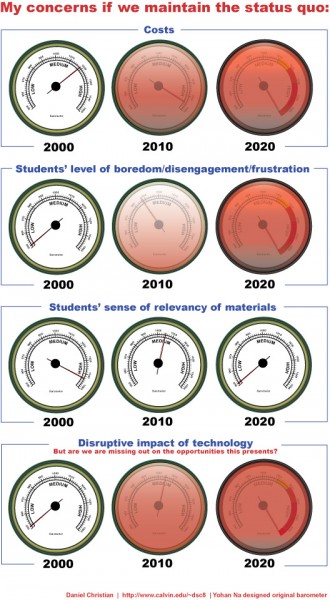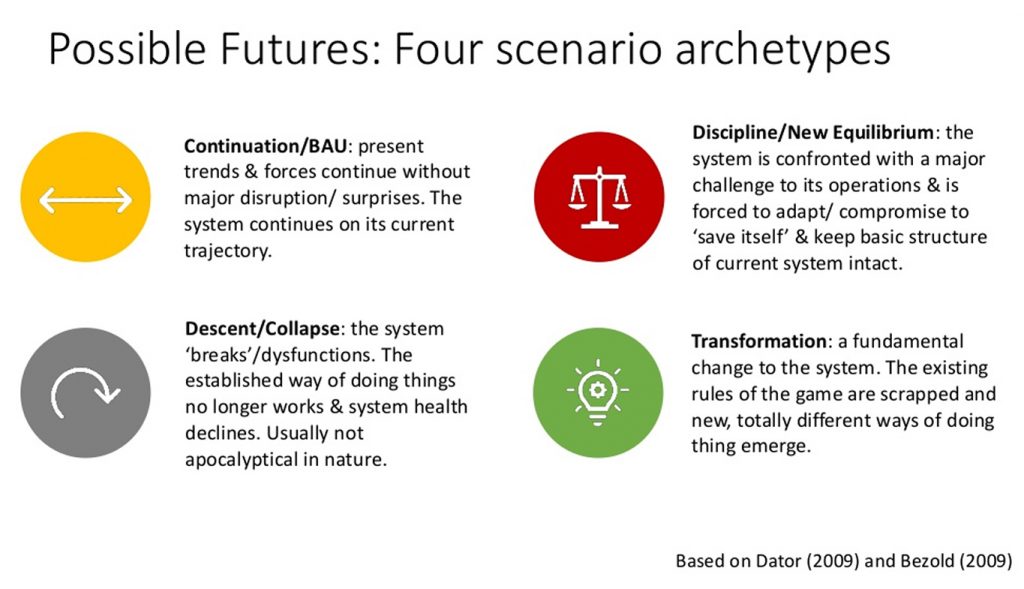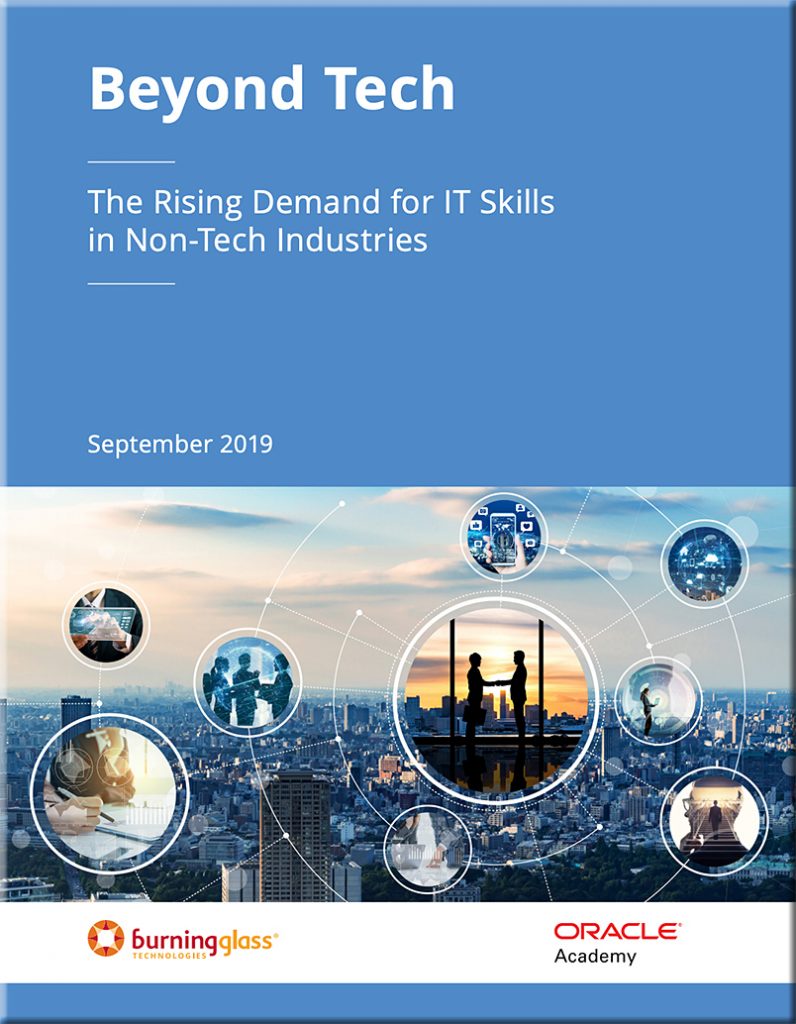Example products/awards:
Also see:
- The List of Winners of the 2019 FutureTech Breakthrough Award — from futuretech.org.tw




Example products/awards:
Also see:
Five principles for thinking like a futurist — from er.educause.edu by Marina Gorbis
Thinking about the future allows us to imagine what kind of future we want to live in and how we can get there.
Excerpt:
In my twenty years at the Institute, I’ve developed five core principles for futures thinking:
As the microcredential market booms, don’t forget the learner — from edsurge.com by Kathleen deLaski
Excerpt:
While this system of microcredentials theoretically will make learning more affordable, portable and relevant, will a diverse range of learners know how and why to take advantage of it? And perhaps more importantly, will they trust it?
The simple answer: only if we intentionally focus on designing around that question.
Also see:
Excerpt:
Higher education is in the throes of a Learner Revolution that will fundamentally change the way students and institutions interact. We see the beginning of this movement now and will see all colleges and universities responding —- or not, at their peril — within a decade. Trends ranging from declining numbers of traditional students, to the rise of artificial intelligence, to the shrinking half-life of job skills have conspired toward this wake-up call moment for all but the most exclusive global higher education brands. At the same time, and partly because of the pressure, leaders are addressing the needs and goals of a changing student population. The calls for “student-centered” design can be heard throughout the ecosystem today, in a way that was just beginning when we started the Education Design Lab.
Colleges and universities must be much more deeply attuned to the twin pressures of learners’ decreasing appetite for debt and employers’ honing of their hiring requirements. That means, in part, an increasing focus on work-relevant skills and competencies—both technical skills and soft skills such as communication and systems thinking. Degrees as the most valuable workforce currency are beginning to give way to more nuanced competencies.
…
Yet, for the estimated three-quarters of students with at least one non-traditional characteristic, higher education has been in need of serious redesign for at least two decades.
Delivering learning across a lifetime: Higher education’s new paradigm — from evolllution.com with thanks to Mr. Amrit Ahluwalia for his work on this
Excerpt:
Higher education is no longer a single engagement in an individual’s life, or a stop-off point between high school and a career.
Today, and into the future, higher education’s role is ongoing as the demands of the future labor market will require individuals to continuously up-skill and re-skill to remain relevant. As such, while the traditional two- or four-year postsecondary model will continue to play an important role, colleges and universities must expand their repertoire to consciously deliver learning across individuals’ lifetimes.
Read on to learn how the 100 Year Life is changing the fundamental learning needs of individuals across the labor market, and to understand how postsecondary institutions can evolve to fulfil their missions within this new paradigm.
From DSC:
This important perspective/trend reminds me of the graphic below…

Also see:

The employee of the future, he added, “typically will have a new job every five years, probably for 60 to 80 years, and probably every one of those will require skills you did not learn in college.”

In case you missed it, WMU-Cooley’s President and Board of Directors took a look at our tuition rates and made the decision to reduce them by 21 percent starting Fall 2020! https://t.co/FjC6hk4vnE pic.twitter.com/NkCMAzoomE
— WMU-Cooley Law School (@WMUcooleylaw) October 16, 2019
From DSC:
Regular readers of this blog will know that for years, I’ve made it one of my goals to try and raise awareness of the need for institutions of higher education to lower their tuitions! For example, Yohan Na and I designed the graphic below way back in 2009.

Through those years, I cringed when I kept hearing various Boards say, “We only increased our tuition by ___ % — the lowest percentage increase in our state.” The direction was completely wrong! It needed to go down, not up. If you work in higher ed, I encourage you to find a way for that to happen at your own institution.
So I’m very pleased to report that the WMU-Thomas M. Cooley Law School — where I work — was able to reduce tuition by 21%!!!
Don’t get me wrong, some tough decisions were made to pave the way for that to occur. But this will be the case no matter which institution of higher education that you look at. An institution will have to make some tough choices to reduce their tuition. But it HAS to occur. We can’t keep this upward trajectory going.
If we don’t change this trajectory, we will continue to put enormous gorillas (of debt) on our graduates’ backs! Such debt will take our graduates decades to pay off.
We need to be aware of these invisible gorillas of debt. That is, our students move on…and we don’t see them. But their gorillas remain.
Addendum on 10/18/19:
Victoria Vuletich, the assistant dean at the Grand Rapids, Michigan campus of Western Michigan University Cooley Law School, was interviewed by the State Bar of Michigan’s Legal Talk Network to discuss what the law school experience is like for the current generation of students.
Information Technology (IT) skills and jobs are widely misunderstood to be housed primarily in the tech sector, and they are also thought to be inaccessible to all but a small minority of people who have focused intently on computer science. Building on our prior research efforts and mining a database of more than 150 million unique online U.S. job postings, Oracle Academy and Burning Glass Technologies produce new evidence that neither of these perceptions are borne out by data. To the contrary, 90% of IT skills and jobs are concentrated in 10 non-tech industries, leaving only 10% in the tech sector. The rapid growth of IT jobs is more than 50% greater in non-tech industries than in tech industries.
Top jobs in 2040 will involve virtual reality, artificial intelligence & robotics — from themanufacturer.com by Jonny Williamson
Emerging technologies such as virtual reality (VR), artificial intelligence (AI) and robotics will strongly influence the careers we do in the future, according to new research from BAE Systems.
Excerpt:
DIY Mindset Reshaping Education — from campustechnology.com by Dian Schaffhauser
Excerpt:
A do-it-yourself mindset is changing the face of education worldwide, according to new survey results. Learners are “patching together” their education from a “menu of options,” including self-teaching, short courses and bootcamps, and they believe that self-service instruction will become even more prevalent for lifelong learning. In the United Sates specifically, 84 percent of people said learning would become even more self-service the older they get.
Among those who have needed to reskill in the last two years to continue doing their jobs, 42 percent found information online and taught themselves and 41 percent took a course or training offered by their employers, a professional association or bootcamp, compared to just 28 percent who pursued a professional certification program, 25 percent who enrolled in a university-level degree program or 12 percent who did nothing.
If people had to learn something new for their career quickly, they said they would be more likely turn to a short training program (47 percent), followed by access to a free resource such as YouTube, Lynda.com or Khan Academy (33 percent). A smaller share (20 percent) would head to an accredited university or college.
From DSC:
This is why the prediction from Thomas Frey carries weight and why I’ve been tracking a new learning platform for the 21st century. Given:

…there needs to be a new, up-to-date, highly responsive, inexpensive learning-related platform for the 21st century. I call this learning platform of the future, “Learning from the Living [Class] Room.” And while it requires subject matter experts / humans in significant ways, AI and other technologies will be embedded throughout such a platform.
“I’ve been predicting that by 2030 the largest company on the internet is going to be an education-based company that we haven’t heard of yet,” Frey, the senior futurist at the DaVinci Institute think tank, tells Business Insider.
— source
Addendum on 9/18/19:
For $400 per course, students will be able to gain access to course videos that are cinematically filmed and taught by “some of the brightest minds in academia.” Outlier.org students will also have access to problem sets, one-on-one tutoring and assessments proctored through artificial intelligence.
Artificial Intelligence in Higher Education: Applications, Promise and Perils, and Ethical Questions — from er.educause.edu by Elana Zeide
What are the benefits and challenges of using artificial intelligence to promote student success, improve retention, streamline enrollment, and better manage resources in higher education?
Excerpt:
The promise of AI applications lies partly in their efficiency and partly in their efficacy. AI systems can capture a much wider array of data, at more granularity, than can humans. And these systems can do so in real time. They can also analyze many, many students—whether those students are in a classroom or in a student body or in a pool of applicants. In addition, AI systems offer excellent observations and inferences very quickly and at minimal cost. These efficiencies will lead, we hope, to increased efficacy—to more effective teaching, learning, institutional decisions, and guidance. So this is one promise of AI: that it will show us things we can’t assess or even envision given the limitations of human cognition and the difficulty of dealing with many different variables and a wide array of students.
…
A second peril in the use of artificial intelligence in higher education consists of the various legal considerations, mostly involving different bodies of privacy and data-protection law. Federal student-privacy legislation is focused on ensuring that institutions (1) get consent to disclose personally identifiable information and (2) give students the ability to access their information and challenge what they think is incorrect.7 The first is not much of an issue if institutions are not sharing the information with outside parties or if they are sharing through the Family Educational Rights and Privacy Act (FERPA), which means an institution does not have to get explicit consent from students. The second requirement—providing students with access to the information that is being used about them—is going to be an increasingly interesting issue.8 I believe that as the decisions being made by artificial intelligence become much more significant and as students become more aware of what is happening, colleges and universities will be pressured to show students this information. People are starting to want to know how algorithmic and AI decisions are impacting their lives.
My short advice about legal considerations? Talk to your lawyers. The circumstances vary considerably from institution to institution.
Screen Mirroring, Screencasting and Screen Sharing in Higher Education — from edtechmagazine.com by Derek Rice
Digital learning platforms let students and professors interact through shared videos and documents.
Excerpt (emphasis DSC):
Active learning, collaboration, personalization, flexibility and two-way communication are the main factors driving today’s modern classroom design.
Among the technologies being brought to bear in academic settings are those that enable screen mirroring, screencasting and screen sharing, often collectively referred to as wireless presentation solutions.
These technologies are often supported by a device and app that allow users, both students and professors, to easily share content on a larger screen in a classroom.
“The next best thing to a one-to-one conversation is to be able to share what the students create, as part of the homework or class activity, or communicate using media to provide video evidence of class activities and enhance and build out reading, writing, speaking, listening, language and other skills,” says Michael Volpe, marketing manager for IOGEAR.
A Financial Crisis — Student Loan Debt — from freedomdebtrelief.com by Micahel Micheletti; with thanks to Aimée Bennett (APR, Principal, Fagan Business Communications, Inc.) for this resource
Key findings
1) Impact of student loan debt on stress, day-to-day life (college attendees/grads)
2) Impact of student loan debt on finances (college attendees/grads)
3) Willing to make sacrifices to eliminate student loan debt (college attendees/grads)
4) Impact of child’s student loan debt on parents
Additional survey findings
1) Student loan debt reforms
2) Expected length of time to pay off student loan debt
3) Lack of knowledge of loan terms, types – among both college attendees/grads and parents
Google brings AI to studying with Socratic — from zdnet.com by Stephanie Condon
Ahead of the new school year, Google is re-launching a mobile learning app it acquired last year.
Excerpt:
Google this week started rolling out a revamped version of a mobile learning app, called Socratic, that the tech giant acquired last year. The updated app, with new machine learning-powered features, coincides with the start of the school year, as well as other Google for Education initiatives.
Socratic aims to help both high school and university students in their studies outside of the classroom. If students need help answering a study question, they can now use the Socratic app to ask a question with their voice, or to take a picture of a question in their study materials. The app will then find relevant material from across the web.
Also see:
Addendum on 8/23/19
Dallas County Community College District Students Receive “GreenLight”? Toward Ownership, Lifelong Access of Academic Records — from linkedin.com by Timothy Marshall; with thanks to Mike Mathews for this resource out on LinkedIn
Excerpt:
(DALLAS) — Gone are the days of a lengthy and sometimes costly process to request educational records for job or college applications. Through its investments in groundbreaking technology, DCCCD is allowing students unprecedented access to their educational transcripts. This places students in the unique position to maintain lifelong digital ownership of their complete academic credentials, with the flexibility to use those records to propel them toward academic and career success.
DCCCD is pleased to announce a new partnership with Dallas-based GreenLight Credentials, a new secure digital locker. With GreenLight, DCCCD students will have wide-ranging access to their academic records anytime, anyplace, by simply clicking a button.


